Flower Bulbs
| Infobox on Flower Bulbs | |
|---|---|
| Example of Flower Bulbs | 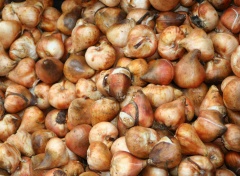 |
| Facts | |
| Origin | Mostly the Netherlands |
| Stowage factor (in m3/t) | - |
| Humidity / moisture | See text |
| Ventilation | See text |
| Risk factors | See text |
Flower Bulbs
Contents
- 1 Flower Bulbs
- 1.1 Description / Application / Shipment / Storage
- 1.1.1 Bulb production
- 1.1.2 Environmental management
- 1.1.3 Bulb flower production
- 1.1.4 Commercial cultivation techniques
- 1.1.5 Plant breeding
- 1.1.6 Vegetative propagation
- 1.1.7 Propagation by means of tissue culture
- 1.1.8 Favourite spring flowering bulbs
- 1.1.9 Favourite summer flowering bulbs
- 1.1.10 Bulbous and Tuberous groups
- 1.1.11 Storage spring bulbs
- 1.1.12 Storage summer bulbs
- 1.2 Various aspects on several flowerbulbs
- 1.3 Flowering bulb diseases
- 1.4 Various transport aspects on containerised flower bulbs in transit
- 1.5 Risk factors
- 1.6 Sources used (which should be mentioned on cargohandbook.com)
- 1.1 Description / Application / Shipment / Storage
Description / Application / Shipment / Storage
Bulb production
In bulb cultivation, a distinction is made between spring-flowering and summer-flowering plants. Growers plant the small bulbs (the planting stock) from this first group that includes tulips, narcissi, hyacinths and crocus in the autumn. The flower bulb grower mulches the rows or beds of bulbs with straw to protect the bulbs during the freezing winter temperatures and/or to prevent the wind erosion of sandy soil. A hyacinth, for example, would freeze during a lengthy period of severe frost.
When the plants bloom in the spring, the grower will usually remove the flowers from the plants. The most important reasons for doing so are to prevent diseases and to encourage growth. Other aspects of cultivation include fertilising, irrigating, removing diseased plants and trueness to variety, and preventing disease. The summer months are the lifting period for spring-flowering bulbs in the period from half June until half July. The small flower bulbs are then separated from the larger saleable bulbs.
Summer-flowering plants such as dahlias, gladioli and lilies, are planted in the spring. The flower bulb grower lifts these bulbous plants before winter sets in, in the period from half September until half November. The cultivation methods are generally the same as for the spring-flowering types.
Flower bulbs are stored at a wide range of temperatures. Storage rooms are kept at temperatures from -2°C to +44°C. With all these different temperature treatments, Mother Nature can really be fooled. It is possible to encourage bulb production during the next growing season, to advance flowering or to retard it, to increase flower production, and even to control diseases. These kinds of treatments are used for flower bulbs throughout the bulb sector: among flower bulb growers, flower bulb dealers, special temperature treatment companies, bulb flower producers, etc.
In comparison with earlier days, the prices for flower bulbs have not risen. This is due to the advanced state of mechanisation combined with the development of large-scaled operations. Planting, applying and removing the winter mulch, deheading of the flowers, lifting, grading and even the traditional bulb peeling are mostly done by machine. This does not mean that labour problems don’t exist, however. In fact, next to the need to improve the environmental friendliness of the growing methods, this is one of the most important concerns for the bulb grower. Every year, it becomes more difficult to find temporary workers for the seasonal harvest peaks.
Environmental management
This may well be the most important concern for today’s bulb growers. Bulb growers are aware that the opportunities for applying crop control agents will only diminish. Permission to use these agents is being withdrawn, the quantities allowed are being reduced, and the permission to use them is subject to increasingly stricter regulations. The various organisations in the bulb sector have now joined the ”Milieu platform” (an environmental consortium for flower bulb growers). Within this consortium, organisations are launching initiatives intended to approach environmental problems in a balanced way. Continued reductions in the use of and dependence on chemical agents, fertilisers and energy are the major topics being addressed. Concrete agreements (covenants) have been made with the government in regard to limiting energy consumption and the use of chemical agents. Results of the environmental discussion include: spray-free zones along the drainage ditches, spraying permits, required inspections of field spraying, modified spraying techniques, keeping fertiliser records, requiring that animal manures be injected into the soil rather than spread on top of it, the growing cultivation of organically grown bulbs, etc.
Bulb flower production
The majority of the cultivated flower bulbs are used for flower production. All the production of iris, tulips, hyacinths, lilies, narcissi, etc, has been preceded by bulb cultivation. Some of this production is done by Dutch flower growers, but a large share of the flower bulbs produced in the Netherlands is sent to similar operations in other countries.
Flower growing operations are also undergoing interesting developments. We can see increases in scale, automation and new production systems. New developments include the hydroponic production of tulips, hyacinths and irises instead of soil, and the use of mobile benches. The production processes of flower bulbs and bulb flowers are closely interrelated. After all, there can’t be one without the other, and you need bulbs to get flowers!
Commercial cultivation techniques
In nature, plants usually propagate by means of seed. The cultivation of flower bulbs, however, is not that dependent on propagation by seed. This type of propagation is used only for plants that are difficult to propagate in any other way or when other ways would be far too costly. When propagating by seed, however, it is crucial that the seeds of the parent plant are true to type, i.e. they will produce plants that look exactly (or almost exactly) the same as the parent plant. Examples of bulbs or corms that are propagated by seed are anemones, Winter aconite (Eranthis), ranunculus and Tigridia.
Plant breeding
Breeding by means of seed is indispensable for obtaining new varieties. This involves the crossing of plants with the intention of obtaining new and improved varieties. This activity has been – and still is – of the utmost importance in the flower bulb sector. The current tulip range is the result of more than four centuries of crossing efforts. If a modern tulip variety is propagated from seed, it will produce a multicoloured mixture of descendants, some of which have undesirable qualities!
Due to the advances made in crossing techniques, it is increasingly possible to create crosses between species or varieties that would not have been possible in the past. This means that highly desirable qualities, e.g. in colour or habit characteristics, can now be achieved by means of crossing. Even more important is the fact that hopefully there will even be more luck in the future in increasing the plants’ resistance to diseases of flower bulbs. This is extremely important to reduce the use of crop protection agents!
Vegetative propagation
Fortunately, most bulbous plants can easily be propagated vegetatively by means of separation of the "daughter" bulbs from the main bulb (hyacinth) or by dividing the entire main bulb cluster (tulip) into several large and small bulbs.
The great advantage of vegetative propagation is that all the desired characteristics will be transferred to the new flower bulbs. Just one tulip bulb of the planting stock will quickly produce two to four "offspring". The narcissus takes somewhat longer to multiply but still grows fast enough to be able to sell about half of the number of lifted flower bulbs. The fastest natural propagation is seen among the gladioli: one large gladiolus corm can produce dozens of small cormels (small corms) in a single growing season.
For lilies and hyacinths, growers have to assist the natural multiplication process. Since hyacinths produce few small bulbs on their own, the base of the bulb is cut away or by cross-cutting to stimulate the production of new little bulbs. To speed up lily production, scales are removed from the flower bulb and given a special storage treatment so that each scale produces one or more small bulbs.
Propagation by means of tissue culture
If the normal propagation methods take too much time or if it is important to produce many bulbs of a new variety within a short time, the flower bulb grower can choose to use "test tube propagation". In tissue culture laboratories, small pieces of bulbs or plants are placed onto special growing media containing plant hormones which stimulate the production of new plantlets or small bulbs. Many lilies as well as zantedeschias are produced this way.
Favourite spring flowering bulbs
During the summer months, the spring-flowering bulb such as tulips, narcissi, etc. are lifted by the growers and delivered to the dealers. Export takes place from August to December.
The Tulip
Of all the bulbous plants, the tulip is the most important. Tulips have been extremely popular as cut flowers and garden plants for many centuries. In 2007, about 10,000 hectares were used for tulip bulb production. The tulip accounts for one-third of the total export value for bulbs. The number of varieties being cultivated is also huge. There are more than 3000 varieties registered, while the number being cultivated on a commercial basis is not more than 750. Tulips are classified into various groups based on their flowering period and shape. Some examples are single, double, fringed, lily-flowered and parrot tulips. There are also tulip groups for botanical tulips and their related varieties. For flower bulb production, the tulip is planted in the autumn (October) and lifted in the summer (June/July).
The Narcissus
The narcissus is in third place of the most cultivated bulbous plants and is grown on a total area of 1.700 hectares. The narcissus has always been a highly favoured bulbous plant and has earned a permanent place in the flower bulb sector. Still commonly cultivated are the trumpet and large-cupped narcissi, although there are many, many other interesting kinds of narcissi (or daffodils). In total, there are about 2000 registered varieties! Even so, only about hundred are commonly available. The colour for narcissi is predominantly yellow, but white, pink and orange occur, too. They are used for both planting in the garden or park and for cut flower production. Among the smaller narcissi, the cultivar known as ‘Tête-à-Tête’ is very popular and with almost 600 hectares in cultivation has even become the leading cultivar. The majority of these bulbs are used for forcing in small pots. For flower bulb production, narcissus bulbs are planted in the autumn (September) and lifted in the summer (July).
The Hyacinth
As one of the bulbous plants cultivated almost exclusively in the Netherlands, the hyacinth is another bulb with a long tradition in the flower bulb sector and has always been a favourite for forcing in pots during the winter months. During the last 30 years, more and more hyacinths have also been used as cut flowers.
Planting them in gardens and parks has been done for centuries. Of all the bulbous plants, the hyacinth is most cherished for its fragrance. Its colours are predominantly pastel: pink, light blue, soft red, white, light yellow and light orange, but brighter colours such as purple and violet are available as well.
The land under cultivation with hyacinths has gradually increased to the present 1.250 hectares. For flower bulb production, hyacinth bulbs are planted in the autumn (October) and lifted in the summer (June/July).
The Crocus
Of all the bulbous plants, this very early spring-flowering corm perhaps gives us the strongest feeling of springtime. With the first rays of sunshine, they stand wide open! Except for a modest number used in forcing pot plants, millions of these corms are used in parks and gardens. Cultivation has fluctuated around 525 hectares in recent years. As most people know, the colours for the crocus are blue, purple, white and yellow. In addition to the most commonly cultivated large-flowering crocuses, there are also small-flowering varieties. And some crocuses flower in the autumn. For production purposes, the corms are planted before winter (November) and then lifted early in the summer (June).
The Iris
Bulbous iris rather than rhizomatous types are probably best known for their unique flower shape comprised of their standards and falls. Of approximately 380 hectares devoted to their cultivation, by far the most of these varieties are blue. Nevertheless, there are also extremely lovely white, yellow and bicolour varieties. Iris are most used for the year-round production of cut flowers. This is done in the field under warmer conditions and otherwise in greenhouses. In the Netherlands, flower bulb growers plant their bulbs in the autumn (September/October). Lifting takes place in the summer (August).
Favourite summer flowering bulbs
The summer-flowering bulbs such as lilies, gladioli, etc. are lifted in September, October and November and then delivered to the merchandising chain through the month of January. After having received their temperature treatments, the saleable bulbs will be sent in early spring to the points of sale where consumers will buy them.
The Lily
Of all the bulbous plants, the lily has shown very considerable growth in terms of hectares cultivated in the last few decades. In 1960, it was being cultivated on just 160 hectares. Now, this figure has risen to 4200! The lily is responsible for 25% of the total export value for bulbs. Its increase in cultivation is primarily due to the new groups of lilies that have been developed for cut flower production. The lily has become a very popular cut flower throughout the world. One of the lily groups, known as the Asiatic Hybrids, offers lilies in orange, red, yellow, white and pink. Also favoured are the Oriental Hybrids with their large white, pink or red scented flowers. Lilies in the Longiflorum Group (including the white ones sometimes known as Easter Lilies) have been grown for a long time, but recent breeding efforts involving the crossing of these lilies with Asiatic Hybrids has produced certain new groups known as the LA-,OT-,LO- and OA Hybrids. These groups are becoming more and more important. In the Netherlands, lily bulb production involves planting the bulbs in the spring and lifting them again before winter. For the production of flowers, the bulbs can be planted throughout the year in many different climate zones, both in the field and in greenhouses.
The Gladiolus
The production of gladiolus corms covers about 900 hectares; this puts it in second place among the summer-flowering bulbs. In terms of the number of hectares used for its production, the gladiolus is close to the narcissus. The number of hectares has decreased somewhat, mostly due to the great interest in lilies. Traditionally, this very colourful bulbous plant has been used for cut flower production in countries with temperate and warm climates, as well as for planting in gardens. These very tall plants have bright, appealing colours: red, purple, yellow, orange and white. In recent years, breeding has considerably increased the colours and flower shapes available in the commercial assortment.
For the production of corms (gladioli are not true bulbs), the growers plant the small corms and “cormels” in the spring (April) and harvest them in the autumn (Mid October/ mid November) when they have grown larger.
The Dahlia
Like the gladiolus, the dahlia is also known for its bright summer colours. The only colour not included in its spectrum is blue. Its array of shapes is extensive as is suggested by the names of the various dahlia groups: pompon, decorative, collar, anemone-flowering, cactus, etc. Of all the bulbous plants, the dahlia has the longest flowering period of all: several months. Of the more than 450 hectares planted, most of the tubers find their way to gardens and parks. A small percentage is grown for cut flower production. Growers plant cuttings in the spring (May) and harvest saleable tubers in the autumn (October).
The special bulbous plants
The special bulbous plants are included in both the spring-flowering and summer-flowering groups. This "miscellaneous" group of "other" bulbous plants just might be the most interesting, however. There are dozens (and maybe even hundreds) of them. The number of hectares used to cultivate them is about 500. Familiar representatives in this group are the Grape hyacinths, Fritillaria, Allium (ornamental onion), Anemone, Hippeastrum (amaryllis), Begonia, Scilla, Canna and Zantedeschia (Calla lily). They are planted in gardens and parks, sold in pots, or used as material for cut flower production. Sometimes, a bulbous plant from this group emerges as a major bulbous plant due to its popularity. This happened with the lily and may also occur again with Zantedeschias. The interest in this "trendy flower" is so great that it is being grown on much more land every year.
During the summer months, the spring-flowering bulbs such as tulips, narcissi, etc. are lifted by the growers and delivered to the dealers. Export takes place from September to December.
The summer-flowering bulbs such as lilies, gladioli, etc. are lifted in October and November and then delivered to the merchandising chain through the month of January. After having received their temperature treatments, the saleable bulbs will be sent in early spring to the points of sale where consumers will buy them.
Bulbous and Tuberous groups
The classification of ornamental geophytes into bulbous and tuberous groups:
| Primary storage and tissue groups | Type | Subclass | Taxa |
| A. Bulbous group | |||
| Scales and leaf bases | Bulb | Dicotyledonae Monocotyledonae | Oxalis cernua Most Allium species, Amaryllis belladonna, Camassia, Chionodoxa, Endymion, Eucharis, Eucomis, Fritillaria, Galanthus, Galtonia, Haemanthus, Hippeastrum, Hyacinthus, Hymenocallis, Iris hollandica, Iris reticulate, Iris xiphiodes, Ixiolirion, Lachenalia, Leucojum, Lycoris, most Lilium species, Muscari, Narcissus, Nerine, Ornithogalum, Polianthes, Puschkinia, Scilla, Tulipa, Urginea, Zephyranthes. |
| Basal plate (stem) | Corm | Dicotyledonae Monocotyledonae | Liatris Acidenthera, Babiana, Colchicum, Crocosmia, Crocus, Erythronium, Freesia, Gladiolus, Ixia, Sparaxis, Tigridia, Triteleia |
| B. Tuberous group | |||
| Stem | Tuber | Dicotyledonae Monocotyledonae | Some Anemone species, Eranthis Caladium, Gloriosa, most Zantedeschia species |
| Roots | Tuberous | Dicotyledonae Monocotyledonae | Astilbe, Dahlia, Eremurus, some Oxalis species Ranunculus, Hemerocallis |
| Stem | Rhizome | Dicotyledonae Monocotyledonae | Achimenes, some Anemone species, some Oxalis species. Some Allium species, Agapanthus, Alstroemeria, Anigozanthos, Canna, Clivia, Convallaria, sime Iris species, some Lilium species, Scadoxus, Zantedeschia aethiopica |
| Hypocotyl | Enlarged Hypocotyl | Dicotyledonae Monocotyledonae | Begonia (Tuberous Hybrids), Cyclamen, Gloxinia None |
Flower bulb production involves the cultivation of flower-producing bulbs, corms, tubers, and rhizomes. In true, bulbs, nutritional reserves are stored in fleshy scales that are parts of the plants’ underground storage organs. Good examples of true bulbs are tulips, hyacinths, irises, lilies and narcissi. The other geophytes (the scientific name for all these plants with underground storage systems)have different types of storage organs. Good examples are gladioli and crocuses (corms), dahlias (tubers) and certain irises (rhizomes).
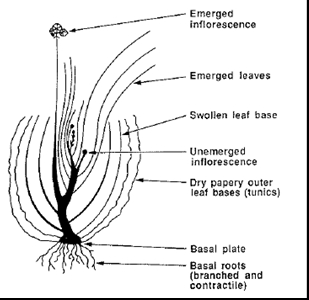
Hippeastrum
An example of a true bulb consisting primarily of enlarged leaf bases. New bulbs continually develop from the centre with a cycle of four leaves and than an inflorescence. Bases of the leaves enlarge to become the scales that contain stored reserves. The oldest scales disintegrate.
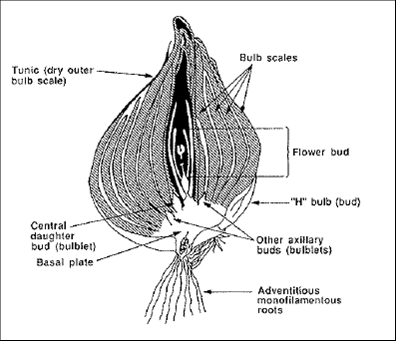
Tulipa
An example of a tunicated bulb comprised primarily of annual replacement scale tissue. Longitudinal section represents the stage of development shortly after the bulb is planted in the autumn.
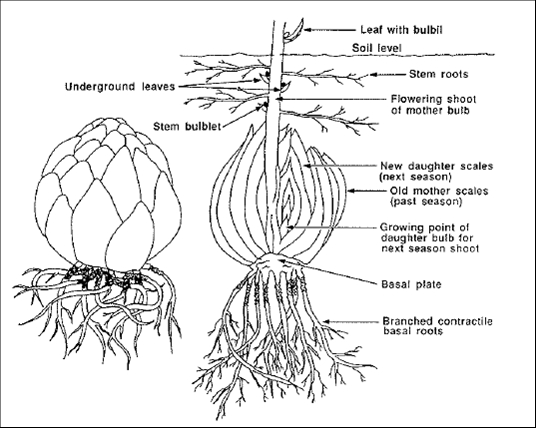
Lilium
An example of a non-tunicated bulb comprised primarily of perennial scale tissue. Left: Outer appearance of an unplanted bulb of L. hollandicum. Right: Longitudinal section of a bulb of L. Longiflorum ‘Ace’, after the flowering stage of development, showing the old mother bulb scales and the new daughter bulb scales in the autumn at lifting time.
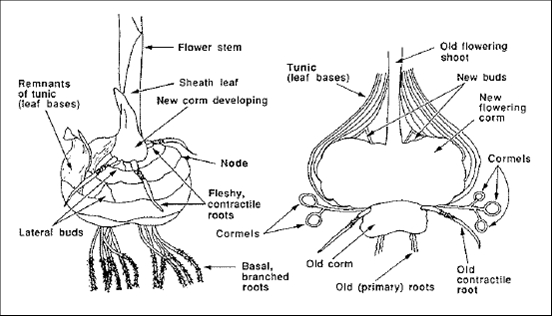
Gladiolus
An example of a tunicated corm comprised primarily of enlarged stem tissue. Left: External appearance in the summer. Right: Longitudinal section showing solid stem structure in the autumn.
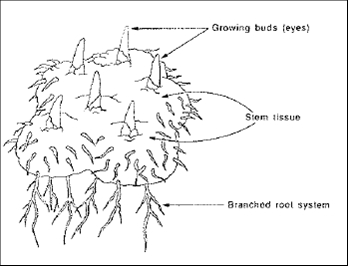
Caladium
An example of a tuber comprised primarily of enlarged stem tissue. Tuber with six large dominant buds or sprouts.
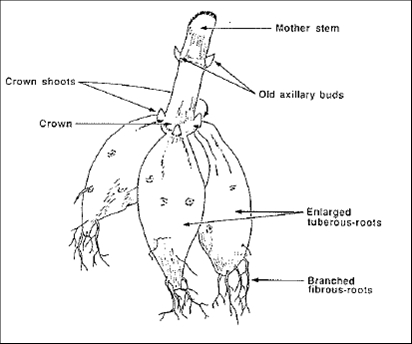
Dahlia
An example of a tuberous root comprised primarily of enlarged root tissue.
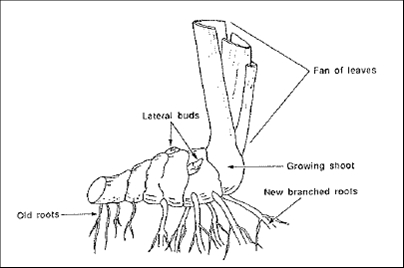
Iris Germanica
An example of a rhizome comprised primarily of a specialised horizontal stem.
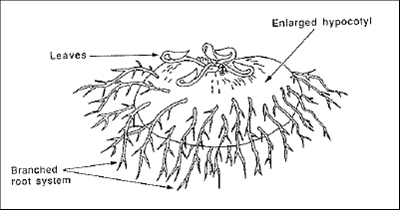
Cyclamen
An example of an enlarged hyopocotyl storage organ
Storage spring bulbs
| Storage method | Temperature until planted °C. | |
| Allium (large and small-flowering) | Dry and ventilated | 23-20-17°C. |
| Allium cernuum, flavum, carinatum, ursinum | Ventilated, protect from drying out | 9-5°C. |
| Amarcrinum | Dry and ventilated | 5°C. |
| Amaryllis belladonna | Dry and ventilated | 5°C. |
| Anemone blanda | Dry and ventilated, provide air circulation | 17°C. |
| Brimeura (syn. Hyacinthus amethystina) | Dry and ventilated | 23-20°C. |
| Camassia | Dry and ventilated | 20-17°C. |
| Chionodoxa | Dry and ventilated | 23-20-17°C. |
| Colchicum | As cool as possible, delivery early | 9-(2)°C. |
| Corydalis, cava, solida | Dry and ventilated | 9°C. |
| Crocus | Dry and ventilated | 23-20-17°C. |
| Crocus (autumn-flowering) | Dry and ventilated, delivery early | 9°C. |
| Eranthis | Dry and ventilated, prevent desiccation | 9-5°C. |
| Eremurus | Protect from drying out | 17-9-5°C. |
| Erythronium dens-canis | Protect from drying out | 9-5°C. |
| Erythronium (other varieties) | Susceptible to mechanical damage | 25-23-17°C. |
| Fritillaria imperialis | Ventilated, susceptible to mechanical damage | 25-23-17°C. |
| Fritillaria meleagris | Protect from drying out, provide air ciculation | 17-9°C. |
| Fritillaria michailovskyi | Protect from drying out, provide moderate air ciculation | 17-9°C. |
| Galanthus | Protect from drying out | 17°C. |
| Hippeastrum (syn. Amaryllis) | Dry and ventilated, 12 wks at 13°C, then 5°C (56°F is preparation, 41°F is storage) | 13-5°C. |
| Hyacint (prepared) | Dry and ventilated | 30-25-20-17°C. |
| Hyacint (not prepared) | Dry and ventilated | 25-20-17°C. |
| Hyacinthoides (syn. Scilla campanulata) | Highly ventilated, susceptible to mechanical damage | 20°C. |
| Iris latifolia (syn. Iris Anglica) | Dry and ventilated, control for aphids | 20-17°C |
| Iris Hollandica | Dry and ventilated | (30)-25-20-17°C. |
| Iris reticulata, danfordiae | Dry and ventilated | 23°C. |
| Ipheion uniflorum | Requires plenty of air circulation; store in shallow layers | 20-17°C. |
| Ixiolirion | Dry and ventilated | 23-17°C. |
| Ixia | Dry and ventilated | 25-23°C. |
| Leucojum aestivum | Dry and ventilated | 20-17°C. |
| Leucojum vernum | Protect from drying out | 9-5 |
| Muscari | Dry and ventilated | 23-20°C. |
| Narcis | Dry and ventilated | 20-17°C. |
| Ornithogalum (large-flowering), e.g. saundersiae, arabicum | Dry and ventilated | 25-23°C. |
| Ornithogalum (small-flowering) | Dry and ventilated | 20-17°C. |
| Oxalis adenophylla | Dry and ventilated | 20-17°C. |
| Puschkinia | Dry and ventilated | 23-20-17°C. |
| Scilla siberica | Dry and ventilated | 25-23-20°C. |
| Scilla peruviana | Dry and ventilated | 23°C. |
| Sparaxis | Dry and ventilated | 25-23°C. |
| Tulipa | Dry and ventilated | 23-20-17°C. |
| Trteleia (syn. Brodiaea) | Dry and ventilated | 23°C. |
Guidelines for storing flower bulbs
This temperature storage chart has been drawn up for dry sales! Modified preparation temperatures can be necessary for purposes of flower production in order to time the flowering periods.
General remarks:
- Storage temperatures apply to properly dried, clean products
- For the forcing sector and for different planting and flowering periods, modified temperature treatments may be necessary
- It may be important to ask the supplier about previously applied storage temperatures
- A decreasing series of temperatures means that the highest temperature should be applied at the beginning of the storage period and that the lower temperatures should be applied towards planting time
- For spring-flowering bulbs, a storage period lasting to planting time is assumed, i.e. no later than mid-December and, in any case, before freezing winter temperatures set in
- If protecting from desiccation is mentioned, it would be advisable to use a filling material, and this should be added to the packaging in any case
- "Dry and ventilated" means to use ventilated packaging
- Pay special attention to aphid control
R.H. = Relative Humidity
Storage summer bulbs
| Storage method | Temperature until planted °C. | |
| Anemone coronaria | Dry and ventilated, constant temperature | 17-15°C. |
| Begonia | Protect from drying out, provide air circulation | 9-5°C. |
| Canna | Protect from drying out, no air circulation | 12-8°C. |
| Cyclamen | Protect from drying out | 9°C. |
| Dahlia | Keep from compacting, avoid draughts, no air circulation | 9-7°C. |
| Eremurus | Protect from drying out | 9°C. |
| Eucomis | Dry and ventilated | 13-9°C. |
| Freesia | Airy, RH 80% | 25°C. |
| Galtonia candicans | Dry and ventilated | 20-17-13°C. |
| Gladiolus | Dry and ventilated | 17-9-5°C. |
| Gladiolus callianthus 'Murielae'(syn. Acidanthera) | Dry and ventilated | 20°C. |
| Gloriosa rothschildiana | Protect from drying out | 20-17°C. |
| Hippeastrum (syn. Amaryllis) | Dry and ventilated (this slows development) | 5°C. |
| Hymenocallis (syn. Ismene) | Dry and ventilated | 25-23-17°C. |
| Iris Hollandica | Dry and ventilated, storage at 30°C will slow development | 30-17°C. |
| Ixia | Dry ventilated, RH 70-80% | 25-23°C. |
| Liatris | If to be stored longer than 3 months: freeze at -2°C/35,5-32°F. | 2-0°C. |
| Lilium | If to be stored longer than 3 months: freeze at -2°C/35,5-32°F. | 2-0°C. |
| Nerine | Dry and ventilated | 9°C. |
| Ornithogalum thyrsoides, dubium | Dry with a highly ventilated container | 30-25°C. |
| Oxalis deppei, regnelli, triangularis | Dry and ventilated | 5-3°C. |
| Ranunculus | Dry and ventilated, constant temperature | 17-15°C. |
| Sauromatum venosum (syn. Arum cornutum) | Dry and ventilated, store frost-free | 5-2°C. |
| Sparaxis | Dry and ventilated, RH RV 70-80% | 25-23°C. |
| Sprekelia formosissima | Dry and ventilated, 6 weeks at 20°C., then 9°C (20°C. is preparation, 9°C. is storage) | 20-9°C. |
| Tigridia pavonia | Dry and ventilated | 5-2°C. |
| Tritonia | Dry and ventilated | 25-23°C. |
| Triteleia (syn. Brodiaea) | Dry and ventilated, RH 70-80% | 25-23°C. |
| Zantedeschia aethiopica | Provide a little air circulation | 13-7°C. |
| Zantedeschia (other cultivars) | Dry and ventilated | 13-9°C. |
| Zephyranthes | Dry and ventilated | 20°C |
Guidelines for storing flower bulbs
This temperature storage chart has been drawn up for dry sales! Modified preparation temperatures can be necessary for purposes of flower production in order to time the flowering periods.
General remarks:
- Storage temperatures apply to properly dried, clean products
- For the forcing sector and for different planting and flowering periods, modified temperature treatments may be necessary
- It may be important to ask the supplier about previously applied storage temperatures
- A decreasing series of temperatures means that the highest temperature should be applied at the beginning of the storage period and that the lower temperatures should be applied towards planting time
- For spring-flowering bulbs, a storage period lasting to planting time is assumed, i.e. no later than mid-December and, in any case, before freezing winter temperatures set in
- If protecting from desiccation is mentioned, it would be advisable to use a filling material, and this should be added to the packaging in any case
- "Dry and ventilated" means to use ventilated packaging
- Pay special attention to aphid control
RH = Relative Humidity
No liability whatsoever is accepted for the consequences that result from the use of this information.
Frost damage
Minor frost damage before the plants emerge generally retards growth and cause the plants to grow twisted. The basal plates are glassy and pale grey. Severely frost-damaged plants do not emerge.
Generally frost damage occurs when the bulbs are stored for some time at temperatures below
-2°C and gradually becomes more serious the longer the bulbs are stored at this temperature. At temperatures lower than -5°C, serious damage occurs even after a few hours.
Diseases and insects
All users of flower bulbs must be familiar with the diseases and insects that affect each species. There are many pests, but usually there are only a few major ones for each species. Knowledge of the major pests and the conditions controlling their development can assist in either eliminating and/or minimizing their effects during postharvest storage.
Bulb flower production: what does this cover ?
Bulb flower production involves the production of flowers by a floriculturist. Actually, the term “bulbs” also includes corms, tubers, rootstocks and rhizomes. Another commonly used phrase is “the forcing of flower bulbs”. Unfortunately, however, this phrase is not always applied correctly; after all, forcing is merely getting bulbs to come into flower earlier – before their natural flowering period outside. But besides getting bulbs to flower earlier than their natural flowering period, the process can also be carried out later. Good examples of forcing are the 5° and 9˚C tulips that are forced during the winter (whilst any tulip bulbs outside will not flower until spring) and what are known as “ice tulips” that are not brought into flower until the next autumn!
Many bulbous plants enter a dormant period after their growth period. To get them to flower earlier than they would under natural conditions, they will have to be subjected to artificial cold and warm periods to break this dormancy. If these periods are cut short or skipped altogether, flowering results will be disappointing or the greenhouse period will have to be greatly extended (the extent of these negative consequences depending on the type of bulbous plant). For certain production methods and their related procedures, the temperature treatment needed to break dormancy will be carried out by the flower bulb supplier in the Netherlands. In other cases, the floriculturist will do this.
Commercially, flower bulbs usage can be divided into two groups. The first group is the ‘Planting Stock’. These are the propagation materials and are generally grown by specialized bulb growers. The second group is the ‘Commercial Bulbs’, which are primarily used for: forcing either as fresh-cut flowers or as potted growing and flowering plants; indoor or outdoor container plants; outdoor fresh-cut flower production; and garden and landscapes.
Optimum postharvest storage conditions in combination with ideal bulb growing conditions and procedures are required to: 1) control (prevent, retard or accelerate) the flowering process from floral initiation to anthesis; 2) assist in controlling certain diseases and insects; and 3) preventing physiological disorders. For each species, it is important to know: 1) precisely when flower initiation occurs; this can be before harvest (e.g. hardy narcissus), during postharvest storage (e.g. tulips and hyacinths) or after planting (e.g. Easter lily); 2) the length of time required for floral development from initiation to anthesis can be a few weeks to several months; 3) the optimal temperatures required to control the entire flowering process; this can range from -2°C to +34 °C, depending on the species, etc.; 4) the sensitivity of the bulb species and/or cultivar to ethylene, which ranges from none to very sensitive; 5) the ventilation requirements, which range from none to high; 6) the moisture requirements, which range from none to high; and 7) the specific diseases and/or insects than can be controlled during the postharvest storage period, which can range from none to several.
Thus, all shipping containers must be able to provide the proper temperature, ventilation, and moisture requirements for the bulbs.
Temperature is the most important factor controlling the growth and development and flowering processes of flower bulbs.
When the taxa require ventilation, it is essential that the flower bulbs receive proper air circulation and exchange during all periods of postharvest storage. Thus the application of these requirements must begin immediately after the grower harvests the bulbs and continue during transportation and subsequent handling by the wholesaler, forcer and/or retailer. The exact ventilation requirement is generally very specific. In general, ventilation rates must be adapted to the storage temperature, i.e. when higher temperatures are used, higher rates of ventilation must be used.
There are two basic considerations for the moisture level for bulb storage. The first is to provide the optimum moisture level, which will prevent desiccation of susceptible bulbs. Thus, materials such as moist peat or wood shavings are used in combination with the various packaging materials, e.g. polyethylene. The second is the control of RH during storage or transportation, which can minimize root development and prevent the development of diseases such as Penicillium. In addition, this approach is an important technique to minimize the use of fungicides either prior to and/or after shipping. Since the registration of fungicides varies with each country and is always subject to change, users must consult with their appropriate governmental agency to determine which pesticides are approved.
With the exception of Dutch Iris, non-planted flower bulbs must not be exposed to ethylene. Most bulbs are physiologically sensitive to ethylene levels of 0,1 ppm and higher. In general, when the flower has been formed and is immature, this plant growth regulator causes either floral abnormalities or complete flower abortion. For severe sensitive bulbs, e.g. tulips, it is advisable to have the storage rooms analyzed for ethylene.
All users of flower bulbs must be familiar with the diseases and insects that affect each species. There are many pests, but usually there are only a few major ones for each species. Knowledge of the major pests and the conditions controlling their development can assist in either eliminating and/or minimizing their effects during postharvest storage.
The production/forcing methods used for the most familiar bulbous plants are summarily presented on the following pages. Because of the number of cultivars and their varied usage, more details cannot be provided since the precise requirements for all taxa are complex.
The need and length of cold storage for bulbs/tubers depends on where the bulbs are grown and for what purpose. It is, therefore, not always possible to make hard and fast rules as to the period of storage. With many bulbs/tubers, cold storage immediately after digging (lifting) and curing is unnecessary during the usual period of use or sale, because they remain in dormant condition for a time, even at fairly high temperatures and humidity. When the rest period is nearly over, however, it usually is necessary to store them at a lower temperature to prevent sprouting and at a relative humidity low enough to prevent rooting but high enough to retard moisture loss.
Basic concept of flower bulb forcing
Forcers must use controlled environmental conditions to regulate the growth and development and flowering of the bulbs. This system of greenhouse growing is called ‘Forcing’. Fundamentally, the process is very easy. However, to successfully carry it out, forcers must have a basic understanding of the principles underlying flower bulb forcing. They are derived from a knowledge of:
1) The origin and morphology of the bulb species.
2) The growth and development and flowering cycle of the species.
3) The influence of environmental factors on the growth and development and flowering cycle of the species.
Origin of the species
Most ornamental flower bulb species originate between 23° to 45° North and South latitudes. Many of the species are indigenous to the Mediterranean region across Asia Minor to China, while others are from America, South Africa, or South America. A climate that predominates in many of these regions consists of cool-moist winters followed by warm-dry summers. A yearly climatic cycle based on temperature is termed ‘Annual Thermoperiodism’. This alternation of temperatures forms the basis for ‘Rooting Room’ forcing and is illustrated by the tulip (see below drawing). In some areas, there are not only annual seasonal changes in temperature, but also wet and dry seasons. Thus, moisture is extremely important for controlling growth of certain species. In addition to temperature and moisture, most flower bulbs are highly responsive to light intensity, photoperiod, and light quality. Clearly, each flower bulb responds to specific environmental factors based on its origin.
Environmental factors
Scientific research and astute observations by individuals have demonstrated that these are at least 12 factors that influence the growth and development of bulb species. Each is very important at some precise stage of growth and development. In general, however, temperature integrated over time is the most important.
Lack of physiological dormancy
True physiological dormancy does not exist in flower bulbs. They act like ‘Biocomputers’ and are continuously undergoing internal change as they monitor their environment. Thus, commercially they must be handled with care (properly) at all times.
Phases of bulb forcing
To integrate the knowledge of the flower bulb growth and development and flowering cycle and the effects of environmental factors, the forcing systems for ‘Rooting Room’ and ‘Non-Rooting Room’ bulbs have been divided into five distinct phases. They are:
1) Production phase
2) Programming phase
3) Greenhouse phase
4) Marketing phase
5) Consumer phase
1) The ‘Production Phase’ encompasses all aspects affecting the growing of high quality bulbs suitable for forcing or outdoor flower production. ‘Quality bulbs’ must be true-to-type and must flower when properly forced or grown outdoors. Many books have been written on bulb growing. In practice, it must be assumed that all production practices will be carried out by knowledgeable bulb growers.
2) The ‘Programming Phase’ :
| Phase | Programming | Greenhouse | ||
| Seasons | Summer | Autumn | Winter | Spring |
| Growth and development processes | Harvesting of the bulbs. Preplanting storage for floral development | Planting and rooting under cool-moist conditions | Mobilisation for flowering under low temperatures | Flower stalk elongation and flowering under warm temperatures |
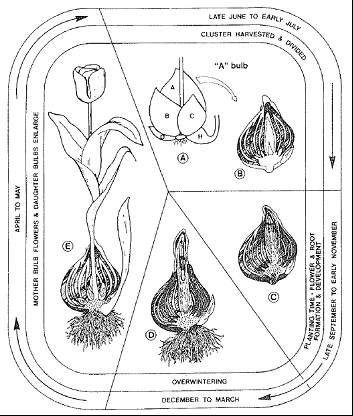
Figure:Annual growth and developmental cycle of a flowering tulip.
A) Harvested cluster; B) Separated ‘A’ bulb; C) Mother bulb with highly developed root and shoot primordial prior to planting; D) Rooted bulb in an overwintering environment; E) Mother bulb at anthesis (flowering), small shoot is the ‘H’ bulb.
Each year the ‘Physiological Maturity’ of the harvested bulbs varies. It is highly dependent upon the prevailing weather conditions of the production season. Sometimes, the weather will be ‘Average’ and the forcing season is ‘Normal’. In other years, ‘Very Mature’ bulbs are produced and the forcing season is ‘Easy’. Conversely, when the bulbs are ‘Physiologically Immature’, the forcing season is ‘Hard’. When extreme seasonal variations occur during the ‘Production Phase’, changes must be made in the forcing schedules, especially in ‘Hard’ forcing years. Also, under extreme climatic conditions some soil-borne diseases, e.g. Fusarium and Penicillium, can become serious carryover problems for forcing.
When serious forcing problems are anticipated due to the bulb production season, the flower bulb supplier must advise the forcer of the situation. Communications on the subject are essential.
After being harvested, all flower bulbs must be packed and stored according to their requirements. Generally, all harvesting, grading and the immediate postharvest temperature treatments are carried out by the bulb grower. Subsequently, the exporter must store them properly prior to shipping. Lastly, the bulbs must be properly transported.
The ‘Programming Phase’ begins as soon as the bulbs are harvested. Initially, warm temperatures given after harvest control the early stages of flower development. With the exception of daffodils (Narcissus) in which flowers are initiated prior to harvest, the immediate postharvest temperatures control the rate of flower initiation and formation in tulips and hyacinths and ‘Specialty Bulbs’, e.g., Crocus, Iris reticulate, Leucojum aestivum, Muscari armeniacum and Scilla tubergeniana (S. mischtschenkoana). Thus, they are used to either accelerate or delay the flowering process for forcing. After the flower(s) is completely formed, but not mature, spring flowering bulbs require a low temperature treatment. This requirement is defined by the number of continuous cold-weeks required by the specific cultivar for the specific flowering period. The cold-weeks must be continuous and the dry cooling (‘Precooling’) weeks and rooted and cooled weeks are added to provide the total cold-weeks used. This ranges from 10 to 13 weeks at 9°C for ‘Prepared’ hyacinths, to 18 – 20 weeks at 0°/9°C for tulip cultivars used for very late forcings. The exact programming temperatures and flowering periods are highly cultivar dependent. In addition, all cultivars of each bulb species are not suitable for forcing while those that are forced are best suited only for specific uses and flowering periods.
3) Greenhouse phase
After the rooting and cooling requirements have been satisfied, the bulbs are transferred to the ‘Greenhouse Phase’. Warm temperatures are used to elongate the flower stalk(s) and expand the leaves to produce either fresh cut flowers or flowering plants.
Regardless of the forcing system used, the goal of the ‘Greenhouse Phase’ is to produce a high quality marketable plant in the shortest number of days. Thus, proper control of temperature, fertilization, moisture, and other factors is essential.
4) Consumer phase
This is a very important phase of any forcing system. Consumers must be satisfied with the performance of the products. Not only must the specific crop be evaluated but also the cultivars. Cultivars usually vary in their vase-life and/or potted flowering life.
5) Marketing phase
The ‘Marketing Phase’ determines the product to be forced and sold. Regardless of whether the product is a flowering potted plant, a fresh cut flower, a growing potted plant or a bulb garden, it is important that the product be sold at the proper stage of development.
Various aspects on several flowerbulbs
Tulip, Hyacinth, Narcissus, Lilies, Gladioli, Iris, Zantedeschia (see below)
Tulip
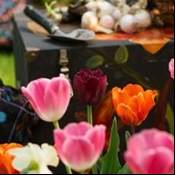
General aspects
The tulip belongs to a group of bulbous plants that need a cold period to ensure flowering and development of sufficient stem length. In regions where temperatures are sufficiently low in winter, tulip bulbs planted in the field undergo this cold period naturally. Research has shown that tulip bulbs which receive their cold treatment before the winter months can be brought into flower before their natural flowering period. This method is called forcing. Depending on the regional climate in which the tulip bulbs are produced, flowering as early as December is possible. The climate influences the development of the new tulip flower shoot until the bulbs are lifted and, provided the bulbs are not treated further in a cold room, even afterwards.
As well as advancing development, the flowering time of tulips may also be delayed. Tulip flowers have been marketed as early as September, October and November for some years now. These so-called ice tulips are produced from bulbs that are stored at low temperatures for an extended period of time. In order to advance the cold period, the bulbs are subjected to a number of temperature treatments. It is vital that the bulbs are not cooled until the flower has developed fully in the bulb, mostly even later.
For very early forcing, most cultivars are given 34°C for 1 week immediately after lifting. Subsequently, they are stored under dry and well-ventilated conditions at 17°C to 20°C. It is very important to be able to identify the stages of flower initiation prior to being pre-cooled at 5°C to 9°C. For medium and late forcing, bulbs are placed at 17°C to 23°C prior to planting at low temperatures. Bulbs are also grown in the Southern Hemisphere for planting in the autumn in the Northern Hemisphere. This eliminates the need and effects of long storage periods.
Cooling temperatures for tulips are 9° C and below. Different temperature will yield different results. For example, ‘high’ as opposed to ‘low’ temperatures will produce:
- Shorter flower stems
- Larger flowers
- Longer greenhouse period
- Less risk of flower blast (in early forcing)
- Faster growth of stems and roots
There are three methods to bring tulips into flower: forcing in trays, cultivation in the border soil of the greenhouse and delaying in trays (ice tulips). Each of these methods relies on one or more cold treatments.
Forcing in trays: 9°C
Bulbs are planted in trays which are then stored in a rooting room or a plunging bed. This method, whereby the bulbs receive the entire cold period in the rooting room or naturally outside, produces so-called ‘uncooled tulips’. Part of the cold treatment can also be given to the dry bulb (9°C tulips) before it is planted in a box to continue and complete its cold treatment.
Forcing in trays is the most commonly used forcing method for tulips. There are a number of reasons for this, including:
- Forcing in trays allows for better planning, without being too dependent upon outside temperatures
- Forcing in trays allows better labour planning
- Relatively few diseases due to the low temperatures in the rooting room. This is an important advantage in view of likely future restrictions or even ban on the use of pesticides.
- Reduced energy consumption due to shorter periods in the greenhouse
- Forcing in trays achieves a higher production of tulips per m2 per forcing season
Forcing in the border soil of the greenhouse
Dry bulbs receive the entire cold period while stored in a cold room at 5°C or 2°C. Immediately following the cold treatment, the bulbs are planted in the greenhouse, ready for flower production to start.
Delaying flowering in trays: Ice tulips
Ice tulips are planted in trays in November, where they remain to root for 2 to 4 weeks at 9°C. After the rooting phase, the trays are frozen and stored at -1,5°C to -2°C. In order to prevent trays from drying out, they are usually wrapped in plastic. From September, trays are generally placed in the greenhouse or in a cool place outside where the bulbs are to flower.
A limited range of tulips is forced into flower in autumn in this manner. Unfortunately, both the flower and the keeping quality of these tulips leave a lot to be desired.
Using bulbs produced in the Southern Hemisphere for 9°C tulips
These bulbs are delivered in May and will already have received part of their required cold period during their transport from the Southern Hemisphere. After receipt, the bulbs should be boxed up immediately and stored for 4 weeks at 7˚C. Next, the temperature in the storage room can be reduced to 0˚C until the housing date. By providing a greenhouse temperature of 14 - 15˚C, flowering can be expected within 15 to 18 days. Depending on the greenhouse climate and the cultivar, flowers can be produced from October to mid- December.
Transport advice
| Temperature | -0,5°C to 0°C. |
| Relative humidity | 65% to 75% |
| Air freshening | 0 to 90 cbm/hr |
| Max. storage life | 150 to 180 days |
| Ethylene production | Very low |
| Ethylene sensitivity | High |
Note: Tulip bulbs may be shipped at any temperature between +5°C and +22°C, depending on the bulbs’ stage of life (= season), variety, and receiver’s purpose of use.
Storage disease(s)
The major storage diseases are Fusarium and Penicillium. Normally Fusarium infections begin in the field and continue during the postharvest storage. There are substantial differences in cultivar susceptibility, but it is important to reduce the number of infected bulbs in storage because of the ethylene they produce. This can lead to flower abortion and abnormalities. Thus the bulbs must be routinely inspected and the rooms monitored for ethylene. Levels in the storage rooms must not exceed 0.1 ppm.
Hyacinth
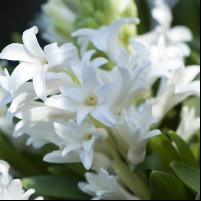
General aspects
Two types of commercial bulbs for forcing are available for greenhouse forcing as either potted plants or fresh cut flowers. The first is ‘Prepared Bulbs’, which are used for very early forcing. After being harvested (in early July), the bulbs are stored under dry and highly ventilated conditions for 2 weeks at 30°C, followed by 3 weeks at 25°C, and then 23°C until the uppermost floret reaches the correct stage. Subsequently, they are stored at 17°C until planted. ‘Regular Bulbs’, which are used for medium and late forcing, are given 25°C followed by 4 weeks at 17°C prior to planting.
Prepared and unprepared hyacinths in pots
Depending on the required flowering period and cultivar, the bulbs receive a cooling treatment at 9°C for 8 to 12 weeks. This cooling treatment is given after the bulbs have been planted in pots. Once potted, the cooling treatment takes place in the rooting room at the floriculturist’s premises. After the cooling period has been completed, the pots are taken from the rooting room and placed in the greenhouse. At a greenhouse temperature of 25° (for Christmas flowering) to 18°C, the pots are ready for sale within 1 to 2 weeks (the warmer, the earlier). Depending on the preparation and the cultivar, the pots are ready for sale from December to April.
Prepared and unprepared hyacinths for cut flower production
Depending on the required flowering period and cultivar, the bulbs receive a cooling treatment at 9°C for 10 to 15 weeks. This cooling treatment is given after the bulbs have been planted in boxes. Once planted, the cooling treatment takes place in the rooting room or on the standing ground at the floriculturist’s premises. After the cooling period has been completed, the boxes are taken from the rooting room or standing ground and placed in the greenhouse. At a greenhouse temperature of 20° to 18°C flowers will be ready for harvest in 2 to 3 weeks (the warmer, the earlier). After harvesting the whole plant, including the bulb, part of the base plate of the bulb just below the stem is left attached to the stem to encourage the proper opening of the florets. Depending on the preparation and the cultivar, flowers can be produced from mid-December to April.
Transport advice
| Temperature | -17°C to 20°C. |
| Relative humidity | 65% to 70% |
| Air freshening | 90 cbm/hr |
| Max. storage life | 60 to 150 days |
| Ethylene production | Very low |
| Ethylene sensitivity | High |
Storage disease(s)
The major storage diseases for commercial sized hyacinth bulbs is Penicillium.
Narcissus
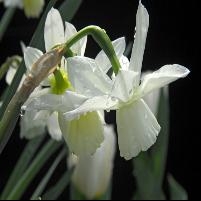
General aspects
Commercial bulbs for early forcing are given 1 week at 34°C followed by 17°C. All the other bulbs are provided 17°C to 20°C. Like most other bulbous plants, most narcissi require a cold period to ensure rapid growth and flowering. A temperature of 9°C provides sufficient cold whereas a cold period of 5°C to 2°C will produce shorter crops.
Forcing in boxes ; nine-degree (pre-cooled) and non-cooled narcissi
Depending on the required flowering period and cultivar, the bulbs receive a cooling treatment at 9°C for 14 to 18 weeks. The cooling treatment is applied after the bulbs have been planted in boxes. The boxes are then placed in the rooting room at the floriculturist’s premises. Part of the cooling treatment can, however, be applied to the dry bulbs (nine-degree narcissi) before planting the bulbs in boxes; once planted, the cooling treatment continues until completed. Then the boxes are taken from the rooting room and placed in the greenhouse. At a greenhouse temperature of 18° to 16°C, flowers are ready for harvest in 2 to 4 weeks (the warmer, the earlier). Depending on the climate and cultivar, flowers can be produced from December to the end of March.
Forcing in pots; nine-degree (pre-cooled) and non-cooled narcissi
Depending on the required flowering period and cultivar, the bulbs receive a cooling treatment at 9°, 5° and then 2°C for a total of 14 weeks. The cooling treatment is applied after the bulbs have been planted in pots, the pots being placed in the rooting room at the floriculturist’s premises. The cooling treatment is applied to dry bulbs (nine-degree narcissi) of long-stemmed narcissi for 6 weeks before potting-up and completing the cooling treatment. After the cooling period has been completed, the pots are taken from the rooting room and placed in the greenhouse. At a greenhouse temperature of 15° to 18°C, the pots are ready for sale in 1 to 2 weeks (the warmer, the earlier). Depending on the climate and cultivar, the pots are ready for sale from December to the end of March.
Forcing in the greenhouse border soil; nine-degree (pre-cooled) and non-cooled narcissi
For this production method, the bulbs receive most or all of their cooling period naturally in the greenhouse border soil. If part of the cooling is applied to dry bulbs (i.e. unplanted), this is done in a cold store at 9°C (for nine-degree narcissi). Once the cooling period has ended, a greenhouse temperature of 18° to 16°C is maintained; the flowers are ready for harvest in 2 to 4 weeks (the warmer, the earlier). Depending on the climate and cultivar, flowers can be produced from December to the end of March.
Transport advice
| Temperature | -13°C to 24°C. |
| Relative humidity | 70% to 90% |
| Air freshening | 90 cbm/hr |
| Max. storage life | 60 to 120 days |
| Ethylene production | Very low |
| Ethylene sensitivity | High |
Storage disease(s)
The major storage diseases are Fusarium and Penicillium. To control Fusarium in the ‘Planting stock’, approved fungicides are added during a hot-water-treatment. This treatment also controls nematodes and bulb flies.
Lilies
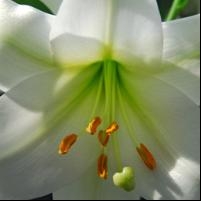
Postharvest storage and transport requirements
To properly flower lilies, the (Commercial) bulbs must be packed in moist peat, wrapped in polyethylene, and packed in trays which are used for storage and shipping. Subsequently they require at least 6 to 8 weeks at 2°C before being planted for early forcing. For late and year-round forcing, the bulbs are ‘frozen-in’ at -1°C to -2°C after being pre-cooled for 6 to 8 weeks.
During bulb transportation the bulb shoot can be easily frozen and it is more cold-sensitive than the vegetative scales. The bulb must be dissected to determine if freezing damage occurred during storage. Blistering of the scale epidermis may be observed and it is associated with small patches of ice under the epidermis. It is known that unplanted and unprotected lily bulbs are killed by temperatures below -5°C.
Cut flower production of bulbs planted in the greenhouse border soil and in the field
For greenhouse production, bulbs from the new harvest are planted directly into the greenhouse border soil, the ideal greenhouse temperature is 14° to 16°C all-year-round. Depending on cultivar, temperature and season, lilies will flower within 10 to 20 weeks. A large percentage of the cultivars can be delivered and planted year-round if stored at temperatures between 0.5° and -2°C. Depending on the climate and cultivar, lilies can also be planted outside in the field. During the summer months, shading protection will be required both in the greenhouse and outside. During light-deficient months, supplementary greenhouse lighting is recommended to prevent flower desiccation. Depending on the climate and cultivars, year-round flowering is possible under protection.
Cut flower production in boxes in the greenhouse
Production is very similar to growing in the greenhouse border soil. Instead of planting in the border soil, however, bulbs are planted in boxes. For optimum rooting boxes are placed in a rooting room at 5° to 12°C; maintaining a lower temperature means slower elongation and the possibility of planting earlier. After rooting, the boxes are placed in the greenhouse. This production method is frequently used for Oriental Hybrid group cultivars for year-round cultivation, but is also used for the initial rooting phase during warm periods of the year. Depending on the climate and cultivars, year-round flowering is possible.
Producing lily flowers from bulbs grown in the Southern Hemisphere
These lilies are usually cultivars in the Oriental Hybrid Group. Compared to Dutch bulbs, these bulbs have been lifted six months later. If planted in the Northern Hemisphere in the autumn, this means that their storage period will have been six months shorter. And a shorter storage period means a crop of higher quality. These bulbs can be planted in the greenhouse soil or in boxes from 1 October to the end of January.
Pot lilies
For pot lilies, bulbs of genetically short cultivars are usually used. Bulbs from the new harvest are planted in pots from December through to December next year and housed in the greenhouse, the ideal temperature being 14° to 16°C. Depending on the cultivar, temperature and season of the year, pots will be ready for sale in 9 to 16 weeks. A large percentage of the cultivars can be delivered and then planted year-round if stored at temperatures between 0.5° and -2°C. Depending on the climate and cultivars, pots can be marketed year-round.
Transport advice
| Temperature | -1,5°C. |
| Relative humidity | 90% to 95% |
| Fresh air ventilation | Closed |
| Max. storage life | 360 days |
| Ethylene production | Very low |
| Ethylene sensitivity | High |
Storage disease(s)
The root rot complex, comprised of a combination of Fusarium, Pythium and Rhizoctonia, is the major disease problem during forcing. It causes several problems including a general loss of quality, stunted growth, and prematurely yellowed and senesced basal leaves. In addition, tolerance to Penicillium is needed.
Gladioli
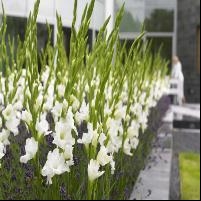
Postharvest storage and transport requirements
After being harvested, cleaned, and then graded, corms and cormlets are initially given 2 to 3 weeks at 15° to 23°C followed by 2°C under highly ventilated conditions for a minimum of 8 to 10 weeks. The latter is required to break the rest period (dormancy) of the corms and cormlets. Corms for commercial uses should be transported at 2° to 5°C under highly ventilated conditions. With the exception of a hot water treatment, unplanted corms are never stored below 0,5°C or above 30°C. Prior to planting, they are given 4 to 8 weeks at 20° to 30°C to promote sprouting. Corms used for very long storage and, thus, very late flowering must be stored at 2°C until planted.
Cut flower production in the greenhouse border soil
During periods of low outside temperatures but where there is sufficient light for the gladiolus’ flower-initiation period, corms can be grown in a greenhouse at 12° to 17°C. Depending on the cultivar and greenhouse temperature, harvesting is achieved in 60 to 120 days. Corms can be delivered year-round.
Cut flower production in the field
During periods when outside temperatures do not get below 10°C but where there is sufficient light during the gladiolus’ flower-initiation period, the corms can be planted outside in the field. Depending on the cultivar and temperature, harvesting can be done in 60 to 120 days. Corms can be delivered year-round. Depending on the climate and cultivar, year-round flowering is possible.
Transport advice
| Temperature | 0°C to 7°C. |
| Relative humidity | 75% to 80% |
| Fresh air ventilation | 25 or 90 cbm/hr |
| Max. storage life | 150 to 240 days |
| Ethylene production | Very low |
| Ethylene sensitivity | High |
Storage disease(s)
To control Fusarium, cormlets are stored at 20° to 25°C for 8 to12 weeks, then soaked in running water for 1 to 2 days at 20°C and then given a hot water treatment for approx. 0,5 hour.
Iris
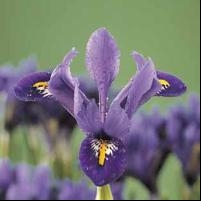
General aspects
Generally, bulbs for very early forcing are stored at 30°C for a few days after being harvested. This is necessary for bulb drying, cleaning and grading. They are subsequently exposed to 500 ppm ethylene for 24 hrs. This treatment stimulates flower initiation, especially with small sized bulbs of some cultivars and bulbs not receiving sufficient heat in the field prior to being harvested. Bulbs for late and retarded (up to one year) forcing are placed at 30°C to suppress their growth and development. Prior to planting they are ‘pre-cooled’ at 5° to 9°C for 6 to 11 weeks, depending on the cultivar. After being pre-cooled, bulbs should be planted as quickly as possible and, if transported, the period should be as short as possible.
Cut flower production in the greenhouse border soil
Depending on bulb size and cultivar, bulbs can be planted in the border soil year-round provided that the soil temperature does not rise above 20°C and that the average greenhouse temperature does not rise above 25°C. The ideal greenhouse temperature is 15°C; a temperature of 18°C can be maintained during the first 3 weeks. This reduces the growing period. Depending on the cultivar and greenhouse temperature, harvesting takes place after 50 to 90 days. Depending on the climate and cultivar, year-round flowering is possible.
Cut flower production in the field
Depending on the climate and bulb size, bulbs can be planted outside in the field year-round provided that the soil temperature does not rise above 20°C and that the average temperature does not rise above 25°C. The ideal temperature is 15° to 17°C. Depending on the cultivar and the climate, harvesting takes place after 50 to 90 days.
Transport advice
| Temperature | 20°C to 25°C. |
| Relative humidity | 65% to 75% |
| Fresh air ventilation | 90 cbm/hr |
| Max. storage life | 120 to 360 days |
| Ethylene production | Very low |
| Ethylene sensitivity | High |
Storage disease(s)
The two major storage diseases of Dutch Irises are Fusarium and Penicillium. To assist in controlling these diseases, it is essential to always handle the bulbs carefully to minimize mechanical damage, which provide sites for disease development. Pre-storage and pre-plant fungicidal dips are generally used for Dutch Iris.
Zantedeschia
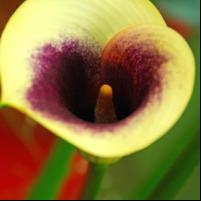
General aspects
It is generally found that there is a 6-8 week rest period following harvest before sprouting will occur naturally, but the longer the storage period the shorter time to sprouting is required regardless of temperature. Storage of the tuber can be undertaken in temperatures as low as 8°C. However, a transport temperature of approx. 13°C is mostly required with low relative humidity and a fresh air supply of 30 cbm/hr.
Producing Zantedeschia flowers in greenhouse soil and outside in the field
In temperate regions (in the Northern Hemisphere) Zantedeschia can be forced into flower in the greenhouse from 1 April to 1 December and can bloom outside from 1 July to 1 October. In subtropical climates, a combination of greenhouse and field production can be used to realise year-round flowering. In either region, and depending on the cultivars being produced, shading to reduce light intensity by 30% will be needed during the warm period to encourage stretching. In the greenhouse, soil temperatures of 15°-18°C and greenhouse temperatures of at least 15°-16°C. should be maintained. Depending on light intensity, the greenhouse temperature can be allowed to reach 20°C but no higher than 25°C. Soil temperatures, however, may never exceed 20°C due to the risk of damage caused by Erwinia. The production period (planting to flowering) in the greenhouse lasts 80-120 days (this range depending on the cultivar) for a spring planting. For field production in the summer, this will be 40-70 days. And for autumn greenhouse production, this will be 60-80 days. Whether year-round planting in greenhouses and outside is possible depends on the local climate conditions and the cultivar selected. In temperate regions (Northern Hemisphere), Zantedeschia can be planted in greenhouses from December to September and planted in the field from late April to mid-July. In subtropical climates, combining greenhouses and field production allows year-round planting.
Zantedeschia as pot plants
When producing Zantedeschia as pot plants, short cultivars are usually used. These are planted from December – August and grown in the greenhouse at a temperature of approx. 16˚C. Depending on light intensity, the temperature can be increased to 20˚C but no higher than 25˚C. Shading will be necessary under conditions of high light intensity. When the plants reach a height of 2-4 cm., a growth regulator is applied. These pot plants will be saleable after 9 to 12 weeks, the exact length of time depending on the cultivar.
Storage disease(s)
The major diseases affecting Zantedeschia are Alternaria species, Bacterial soft rot, Penicillium (considered more unsightly than detrimental to growth) and Phytophthora. However, generally Zantedeschia are remarkably tolerant to most diseases.
Flowering bulb diseases
The term bulb is used in a general way to describe any plant with a swollen storage system. This includes true bulbs (for example, daffodils, tulips and lilies), corms (which include crocuses and gladioli), tubers (begonias, anemones and cyclamens), and rhizomes for example some irises and trilliums). If one starts with healthy bulbs, bulb diseases are generally not a problem.
Most diseases that can affect bulbs do not generally become a problem, if one starts with healthy bulbs and plant them in sterilized soil. Some of the common problems that may occur include several types of bulb rots, viruses and nematodes.
There are various disease-causing fungi that live in the soil, which can cause bulbs to rot. Plants that are affected may be stunted and have yellow leaves. In some cases plants may fail to emerge. A whitish growth may be visible on the underground shoots and bulbs.
These diseases occur mainly under cool, moist weather conditions and in soggy soils. Remove and discard infected plant material.
Bacterial rot, or soft rot, may begin as a slow yellowing of the leaves often beginning at the leaf tips. Leaves may wilt, collapse and die. Bulbs and the base of the leaves decay and often have a foul-smelling odour. Soft rot is most serious in wet, heavy soils. Provide adequate drainage, and remove infected plants.
Viruses can infect plants, causing leaves or flowers to be mottled or discoloured and growth to be distorted. Control aphids and other sucking insects, which can spread viruses. Dig up and destroy infected plants.
Most common bulb diseases
| Symptoms | Small, yellowish spots on leaves; shoots twisted; bulb has dark-coloured scales with yellowish pockets that contain microscopic worms. |
| Causes | Stem and bulb nematode (Ditylenchus dipsaci) |
| Plants affected | Narcissus |
| Prevention and treatment | Dig infected bulbs, along with the layer of soil surrounding the bulbs and destroy. Treat infected soil by solarisation (remove all the plants, till, and cover the bare soil surface with clear plastic for a month to six weeks) or avoid planting bulbs in infected soil. |
| Symptoms | Bulbs rot, pink or white mould is visible; leaves are stunted, yellow and die. |
| Causes | Basal rot (Fusarium oxysporum) |
| Plants affected | Narcissus |
| Prevention and treatment | Basal rot is common on bulbs planted in locations with soggy soils. When digging and replanting bulbs, check each for disease and discard any with spots or soft areas. Spray plants with a systemic fungicide. |
| Symptoms | Water-soaked lesions on leaves. |
| Causes | Anthracnose (Gloeosporium spp.; Colletotrichum spp.) |
| Plants affected | Anemone |
| Prevention and treatment | Remove infected bulbs and treat infected soil. |
| Symptoms | Leaves or flowers are mottled or discoloured; growth distorted. |
| Causes | various viruses |
| Plants affected | Gladiolus, Lily and Tulip |
| Prevention and treatment | Viral infections usually strike plants that are weakened by poor environmental conditions. Control aphids and other sucking insects, which can spread viruses. Dig and destroy infected plants. |
| Symptoms | slow yellowing and death of leaves stating at leaf tips, wilt and collapse, foul smelling decay of bulbs, leaf sheets and leaf bases. |
| Causes | Erwinia carotovora (soft rot) |
| Prevention and treatment | Soft rot is most serious in older plantings and in wet, heavy soils. The bacterium is favoured by warm, wet weather. Provide adequate drainage, remove infected plants and treat infected soil. |
| Symptoms | Leaves turn yellow; plants are stunted and die prematurely; soft fibrous rot of bulb, somewhat of a dry rot. |
| Causes | Sclerotium rolfsii (Crown rot or Southern Blight) |
| Plants affected | Iris, Narcissus, Gladiolus, Tulips and Amarylis |
| Prevention and treatment | Destroy infected plant materials and fumigate the soil. |
| Symptoms | Leaves fail t emerge or emerge, turn yellow, wilt and die; underground shoots and bulbs are covered with shite mycelium; top of bulbs are infected first, then bulb decay (softy black spots). |
| Causes | Sclerotinia bulborum (black or black rot) |
| Plants affected | Crocus, Fritillary, Hyacinth and Scilla |
| Prevention and treatment | This is a cool, moist weather problem. Destroy infected plant materials and treat infected soil. |
| Symptoms | Plants fail to emerge, or emerge turn yellow and die; lack of flowers; bulbs decay (mushy rot with a sour odour), blue-green mould covers the bulbs. |
| Causes | Penicillium spp. (blue mould) |
| Prevention and treatment | Avoid wet, poorly drained soils, destroy infected plant materials; control wireworms (bulbous iris), and treat infected soil with fungicides (thiabendazole, Mertect 340). |
| Symptoms | Weak shoots turn yellow and die; Rhizomes shrivelled and partially decayed (gray-brown, dry, pithy, and odourless with a distinct dark band between healthy and diseased tissue). |
| Causes | Botrytis sp. (gray mould) |
| Plants affected | Anemone, Lily, Snowdrop, Tulip. |
| Prevention and treatment | Destroy infected plant material, fungicide dip or drench (thiophanate methyl). |
Flowering bulb insect pests
The most common pests of flowering bulbs in general are aphids, bulb mites and slugs and snails. In addition, thrips, bulb flies, borers and leafrollers among others can also cause problems for certain flowering bulbs. While slugs and snails are not insects, they are major pests of flowering bulbs.
Aphids
Various species of aphids are pests of flowering bulbs. Aphids are small, soft-bodied, pear-shaped insects. Different aphid species vary in colour from yellow to green to pink to black. Adult aphids may or may not have wings.
Aphids are typically more of a problem during cool weather in the spring. They have piercing-sucking mouthparts, and are usually found in clusters feeding on new growth. They insert their mouthparts and suck plant sap. Their feeding can cause deformed growth of leaves and flowers. In addition, as they feed they excrete a sugary material called honeydew, which covers the leaves making them sticky. Sooty meld fungi can grow on the honeydew, producing unsightly, dark splotches on the plant surfaces.
Bulb mites
Bulb mites (Rhizoglyphus species) are not insects but are more closely related to spiders. Adult bulb mites are tiny, yellowish-white, somewhat transparent, and slow moving. They feed on the bulb, causing weakened plants, stunted, off-colour leaves and deformed flowers. Infested bulbs often develop soft dying areas and fail to grow.
Thrips
Several thrips species, including gladiolus thrips (Taeniothrips simplex), onion thrips (Thrips tabaci) and flower thrips (Frankliniella tritici) are pests of various flowering bulbs. Adult thrips are slender, tan to dark brown in colour and about 1/20 to 1/16 inch in length with fringed wings. They tend to be found in protected areas of the plant.
Both adults and nymphs (immature insect stage resembling the adult, but smaller) feed by scraping surface cells to suck plant sap. When they feed on flower buds, the flowers may die without opening. With light infestation, their feeding causes leaves to have brown or silvery speckles or streaks. With severe infestations, leaves and flowers are stunted and distorted and may turn brown and die.
Bulb flies
Lesser bulb flies: Lesser bulb flies (Eumerus species) range in size from 0,5 to 1 cm. in length. They are dark blue with a metallic bronze sheen. The larvae (maggots) range in size from 0,2 to 1 cm. and in colour from white to greyish yellow.
The maggots enter and then tunnel through the bulb. The bulbs begin to decay and fill with a semi liquid material. They may be killed outright or damaged so that only very small leaves are produced the following year. The maggots survive the winter in the bulb and the following spring they emerge into the soil where they pupate (transform to a nonfeeding stage where the larva changes to an adult form). The adults emerge, mate and the female crawls down through openings in the soil such as those left by leaves as they die to lay eggs on or near bulbs as well as on the soil surface and on the leaves at the neck of the bulb.
Narcissus bulb fly
Narcissus bulb flies (Merodon equestris) look like small bumble bees with bands of yellow or orange brown on their bodies. The larvae (maggots) are plump, greyish-white to yellow and range in length from 0,2 cm. when newly hatched to 2 cm. when mature.
The adult fly lays eggs on the leaves near the soil surface or on the crowns. When the eggs hatch, the maggots tunnel into the bulbs where they feed on the soft tissue. The bulbs are often hollowed out as a result of the feeding and feel soft and spongy. Once infested, bulbs often rot. Some survive, but generally produce small, weak leaf blades the following year. The maggots overwinter in the bulb and then move into the soil in the spring to complete their life cycle.
Iris Borer
Iris borer (Macronoctua onusta) is the most serious pest of iris. It is the larva (caterpillar) of iris borer moths. The mature caterpillar can reach 3,5 cm. in length. It is pale yellowish-pink to pink with a brown head and has rows of black spots along its sides.
The adult moths that emerge late in summer, mate and lay eggs on old iris leaves and nearby plants. The borer overwinters (survives the winter) as eggs. In the spring, tiny caterpillars hatch out and feed on new leaves. As a result of the feeding, the leaf margins may appear water-soaked, bleed plant sap and become ragged. The caterpillars then mine (feed in slender tunnels) inside the leaves before moving down to the rhizomes. They may feed on the outside of the rhizome or bore inside and feed until they mature. A single iris borer can ingest the entire contents of a rhizome before moving to another rhizome. It is common for bacterial and fungal root rot to develop in borer damaged rhizomes. At maturity the borer leaves the rhizome and enters the soil to pupate (transform into the nonfeeding stage where the larva changes into an adult form). Iris borer damage is generally first noticed in the fall when the damaged rhizomes are dug for transplanting in late summer.
Lesser Canna Leafroller
The lesser canna leafroller (Geshna cannalis) is the larva (caterpillar) of the lesser canna leafroller moth. The caterpillar ranges in size from 0,2 cm. when newly hatched to 2 cm. when mature. As it matures its body changes from cream to greenish in colour, but its head remains yellowish.
The leafrollers survive the winter in rolled, dead leaves of the canna. They mature to adults, which appear in the spring. Adult females lay their eggs on the canna. Initially the tiny, newly hatched caterpillars tunnel inside the leaves between the upper and lower surfaces. When they become too large, they exit to the upper leaf surface where they fasten edges of leaves so that the leaves cannot unfurl or they can roll one edge of an already open leaf. While in this protected area, they generally feed on the leaf’s upper surface but will also bore through the rolled leaf. Infested leaves often have several holes through them. Heavily infested leaves may not open at all and the plants may fail to bloom. When fully mature, the caterpillars spin a cocoon where they transform to adults. More than one generation occurs per year.
Various transport aspects on containerised flower bulbs in transit
Time
Ocean transit time incl. of expediting and dwelling periods of containers may take two to four-plus weeks.
Temperature
Considering the operating environment, the equipment used on a modern ocean vessel is very robust and reliable, allowing accurate and consistent temperatures within the container. All shipments, however, should have at least two portable recorders to monitor the temperature of the air flowing around the bulbs. These are invaluable should a malfunction occur within the container’s control equipment. It is recommendable to place one recorder at the front bottom of the container, to register the supply air. Another recorder may be placed amongst the rear part of the cargo load, preferably half height at approx. 1 m. distance from the door-end.
Ventilation and ethylene
The major disease problem particularly facing tulip bulb forcers is Fusarium. This disease infects the basal area of the bulbs and is known to be a greater problem if field temperatures are high in the last 3-4 weeks before digging. Some large cultivars are also more susceptible.
Fusarium becomes a transportation issue when we realize the Fusarium fungus produces large quantities of ethylene. A key reason for ventilating containers, and for immediately unpacking and ventilating bulbs upon arrival at the receiving facility, is to remove ethylene from the atmosphere surrounding the bulbs. It is crucial to understand that the ethylene produced by a single ‘fusarium bulb’ can injure numerous surrounding bulbs, both in the shipping container and pot or forcing box.
Ethylene injury in tulips is expressed as uneven, stunted growth, flower bud withering or complete flower bud necrosis before the bud emerges from the bulb. For example, the disorder called ‘kernrot’ can be seen in dry bulbs in the early autumn. It begins with ethylene-stimulated shoot growth leading to the ‘opening’ of the tip of the tulip bulb. At that point, mites are able to enter the bulb and crawl down to the young developing bud. Their feeding causes the actual death of the bud. When forced, the resulting plant has one to three leaves, but no stem elongation or flowering. The bud is merely a blackened stump.
In tulips, ethylene exposure leads to another disorder called gummosis. Gummosis is the formation of a hard, clear, brownish-tan substance on the external surface of the bulb. A shipment with a substantial proportion of gummosis tulips is very suspect and the supplier should be notified.
Humidity
The relative humidity inside a shipping container is another critical factor for a problem-free bulb shipment. Especially with pre-cooled shipments at (9ºC), warm, humid air entering the container during ventilation can cause water to condense on the bulbs. In such cases, immediate drying with fans is essential upon arrival at the warehouse. Failure to do so can increase disease problems.
Risk factors
A great variety of bulbs are shipped in well madder cases or cartons. Damage should be considered in the light of stowage, packing and the probability of pre-shipment damage not immediately apparent. Special stowage is usually required and this should invariably be studied. Packing and stowage varies with season and the particular type of bulb.
The following may be of assistance:
Frost
Most types of bulbs are susceptible to damage by frost. Decomposition, humidity and slime are the external features, while internally discoloration occurs. This damage may occur while awaiting shipment or after discharge. Begonia and gloxinia corms are probably the most sensitive of all bulbs. When these two types are chilled they will not grow. Frost damaged corms will decompose immediately they are exposed to normal temperature.
Sweat
Damage can also arise from sweat, brought about by fluctuation of temperature during voyage. Sweat can also occur when bulbs are shipped too early after harvesting.
Rooting
Usually dried out roots signify old roots. With certain types of bulbs, if roots longer than 3 cm have developed, and they are only few in number, there is no likelihood of injurious effect as there are sufficient root buds to ensure normal root growth. This assumes no damage to the basal plate itself and the absence of mould; otherwise, damage is possible. With some bulbs, no ill effects follow from rooting in transit unless there has been excessive delay.
Mould
Mould on outer skin of bulbs does not always assume damage. It could be brushed off after drying. Sprouting: This usually occurs in spring shipments but is generally not harmful unless the sprouts are of an extensive length. Also, if pre-cooled bulbs have been too long in shipment, they can or will show excessive sprouting.
Sources used (which should be mentioned on cargohandbook.com)
Abstractions from BMT Consolidated Manual on (Dutch) Flower bulbs, cut flowers/greens and potted plants











